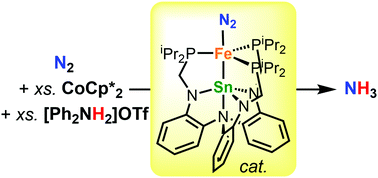Bimetallic iron–tin catalyst for N2 to NH3 and a silyldiazenido model intermediate†
Abstract
A tin-supported iron catalyst produces 5.9 turnovers of NH3 from N2, using [Ph2NH2]OTf as the acid and CoCp2* as the reductant. Two redox states of the Fe(N2) adduct and an Fe silyldiazenido complex were characterized using X-ray crystallography along with NMR and Mössbauer spectroscopies. Density functional theory calculations reveal that the charge on the Sn center correlates strongly with both the polarization of the N2 moiety and the charge on the distal N atom.

- This article is part of the themed collections: Chemical Communications HOT Articles and Bioinspired metal complexes for chemical transformations and catalysis


 Please wait while we load your content...
Please wait while we load your content...